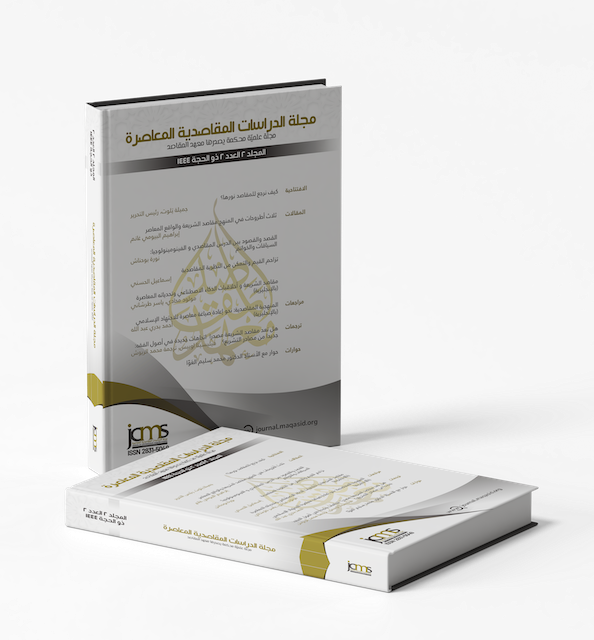التزكية المفهوم والأبعاد
Keywords:
Tazkiyah, education, behavior, revelation, balance, comprehensivenessAbstract
Tazkiyah (purification) is a key objective of divine revelation and a primary mission of prophets. It represents the essence of human existence and the path to success in this world and the hereafter. Central to human development, Tazkiyah engages all dimensions spiritual, intellectual, emotional, and behavioral—following a divine methodology characterized by balance, integration, and continuity. This paper explores the concept through divine revelation, highlighting its essence, dimensions, and functions. It identifies Tazkiyah as a governing principle aimed at purifying and elevating individuals and communities, preparing humanity for civilizational development and stewardship. The study recommends practical activation through da’wah and educational initiatives, supported by actionable methodologies for real-world application.
References
References
Al-Abdul Latif, A. A. (1414). Landmarks in Behavior and Purification of Souls. Dar Al-Watan.
Al-Ansari, F. (2009). The Eloquence of the Quranic Message: A Vision of the Verses of the Path.
Al-Farahidi, K. A. (n.d.) Al-Ain. Dar and Library of Al-Hilal.
Al-Ghazali, A. H. (n.d.) The Revival of the Religious Sciences. Dar Al-Ma’rifa.
Al-Ghazali, M. (n.d.) The Arrows of Truth. Dar Al-Qalam.
Al-Jilani, A. (n.d.) Al-Ghaniya. Dar Al-Albab.
Al-Kafwi, A. (n.d.) Al-Kulliyyat. Al-Risalah Foundation.
Al-Najjar, M. (2019). The Objectives of the Qur’an in Purifying Man. Islamic Knowledge Magazine, 24(95).
Al-Qaradawi, Y. (1996). An Introduction to Knowing Islam. Wahba Library.
Al-Qushayri, A. The Qushayri Epistle. Dar Al-Ma’arif.
Al-Raghib Al-Isfahani, I. (1991). The Vocabulary of the Strange in the Quran. Dar Al-Qalam, Dar Al-Shamiya.
Al-Rahmani Al-Mubarakfuri, S. (1984). The Pasture of the Keys: An Explanation of Mishkat al-Masabih. Scientific Research, Call and Iftaa Administration, Salafi University.
Al-Sayed, A. (2009). Islamic Education: Its Origins, Method, and Teacher. Al-Maktaba Al-Shamela.
Al-Shawkani, M. A. (1991). Fath Al-Qadir. Dar Al-Khair.
Bukhari, M. I. (1993). Sahih. Dar Ibn Kathir, Dar Al-Yamamah.
Hawa, O. (1999). Our Spiritual Education. Dar Al-Salam for Printing, Publishing, and Distribution.
Ibn al-Athir, I. (1979). The End of the Strange Hadith and Trace. Scientific Library.
Ibn Faris, I. (1979). Measures of Language. Dar al-Fikr.
Ibn Qayyim al-Jawziyyah (1431), I. The Key to the House of Happiness and the Manuscript of the State of Knowledge and Will. Dar al-Kutub al-Ilmiyah.
Ibn Qayyim al-Jawziyyah (1996), I. The Stages of the Seekers. Dar al-Kitab al-Arabi.
Ibn Qayyim al-Jawziyyah (2019), I. The Path of the Two Migrations and the Gate of the Two Felicities. Dar Ataaat al-Ilm, Dar Ibn Hazm.
Ibn Qayyim Al-Jawziyyah, I. (2019). The Disease and the Cure. Dar Ataaat Al-Ilm, Dar Ibn Hazm.
Ibn Taymiyyah, I. (2004). Collection of Fatwas. King Fahd Complex for the Printing of the Holy Qur’an.
Muhammad Qutb, M. (1976). The Method of Islamic Education. Dar Al-Shorouk Edition.
Muslim, I. (1955). Sahih. Dar Ihya’ Al-Turath Al-Arabi.
Omar, A. H. (2008). Dictionary of Contemporary Arabic Language. Alam Al-Kutub.
Sayyid Qutb, S. (1986). In the Shade of the Quran. Dar Al-Shorouk Edition.
The Arabic Language Academy. The Intermediate Dictionary. The Arabic Language Academy.
Zarrouk, A. The Rules of Sufism and Evidences of Recognition. Arab Center for Books Edition.
Downloads
Published
How to Cite
Issue
Section
License
Copyright (c) 2025 Journal of Contemporary Maqasid Studies

This work is licensed under a Creative Commons Attribution-NonCommercial 4.0 International License.






